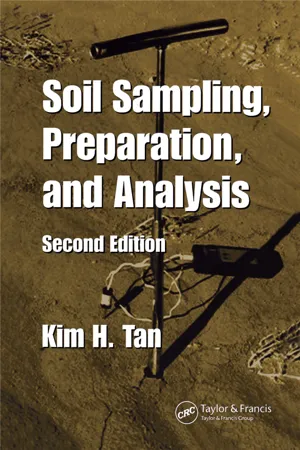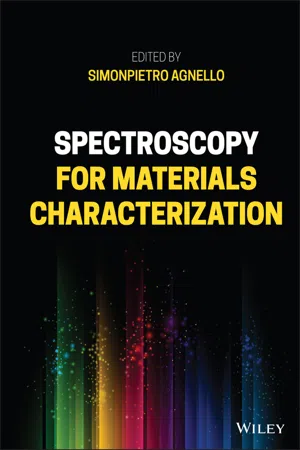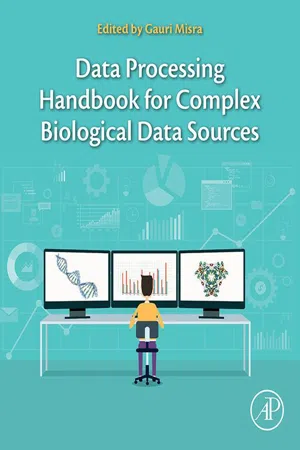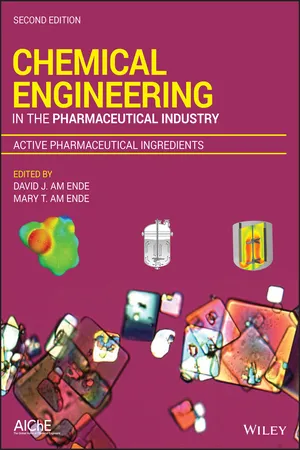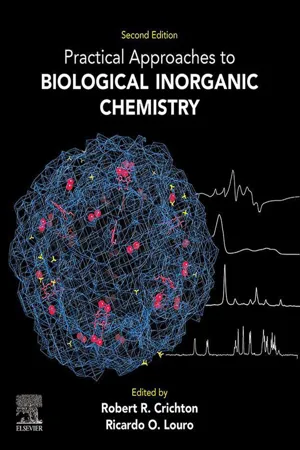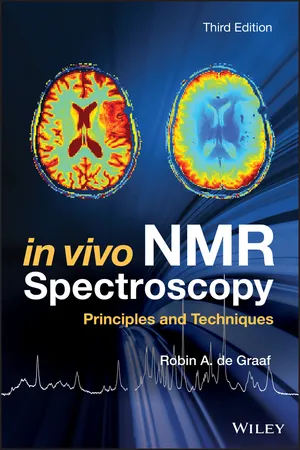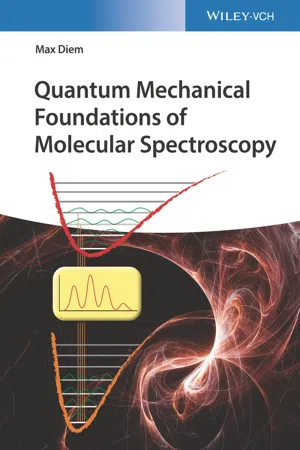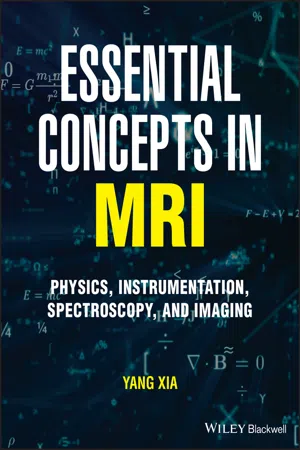Chemistry
Understanding NMR
Understanding NMR (nuclear magnetic resonance) involves the study of how atomic nuclei behave in a magnetic field. NMR spectroscopy is a powerful analytical technique used to determine the structure and composition of molecules. By analyzing the interactions between nuclei and magnetic fields, NMR provides valuable information about chemical environments and molecular structures.
Written by Perlego with AI-assistance
Related key terms
Related key terms
1 of 4
Related key terms
1 of 3
12 Key excerpts on "Understanding NMR"
- eBook - ePub
- Kim H. Tan(Author)
- 2005(Publication Date)
- CRC Press(Publisher)
As is the case with SEM, NMR spectroscopy is also a nondestructive or noninvasive method of analysis. However, the high cost of an NMR spectrometer is for many scientists a major drawback, and without sizeable research grant funding at their disposal, only the most affluent laboratories can afford the luxury of possessing one. Nevertheless, the less fortunate can acquire the use of them through personal relations or cooperative research.20.1 Principles of NMR
The basics of NMR discussed in many of the books and articles are far from simple, and if not confusing, often defy the logic of most common scientists. Therefore, the present author has tried ‘translating’ these principles of NMR into a language less bewildering so that all can read and follow it.Nuclear magnetic resonance spectroscopy is one of a group of analyses by which the nuclei of atoms (in the sample) are subjected to interactions with magnetic radiation, resulting in excitation of the nuclei. This is followed by relaxation (returning to the original condition) and the absorbed or excess energy is lost again (emitted) from the nuclei in the form of a weak or faint radio frequency signal. In NMR, these frequencies are typically in the range of 100 to 600 MHz.20.2 Nuclear Spins and NMR Signals
The bare principles above can be described more scientifically as follows. Atomic nuclei exhibit mass and charge, whereas many of them are spinning, and scientifically they are stated as having spin and angular momentum. Because of the spinning charge, a magnetic field is developed characterized by a magnetic moment, μ, (Willard et al., 1974; Pfeffer and Gerasimowicz, 1989), or in simpler words, the nucleus behaves as a very small magnet with its axis synchronous to the axis spin.Due to thermal and other effects, these small spinning nuclei are present in matter (the sample) in disarray. However, when they are placed in a strong external magnetic field, Bex , they tend to orient (align) themselves to the external magnetic force (Figure 20.1 ). The nuclei are then forced to excitation by the application of a second, weaker, external magnetic force, B1 generated at right angles to Bex . The transfer to a higher state of energy level occurs by varying the generated force of B1 so that its frequency equals the frequency, characteristic of the nucleus under analysis, called the Larmor frequency. Pfeffer and Gerasimowicz (1989) indicate that a Bex field of 9.3 Tesla requires generating a B1 Larmor frequency of 100 MHz for excitation of 13 C, and 400 MHz for excitation of 1 - eBook - ePub
- Simonpietro Agnello(Author)
- 2021(Publication Date)
- Wiley(Publisher)
10 Nuclear Magnetic Resonance Spectroscopy Alberto Spinella1 and Pellegrino Conte2 1 Advanced Technologies Network Center (ATeN Center), University of Palermo, Palermo, Italy 2 Department of Agriculture, Food and Forestry Sciences, University of Palermo, Palermo, Italy10.1 Introduction
Nuclear magnetic resonance (NMR) spectroscopy is a powerful technique used in many fields from basic to applied sciences in order to characterize both molecular and supramolecular structures of organic and inorganic compounds. Among the various spectroscopic techniques, NMR is one of the most versatile due to its ability to unveil three‐dimensionality of molecular systems in each of the three different physical states (liquid, solid, and gas) and regardless of sample crystallinity.Purcell, Torrey, and Pound at Harvard University [1] and Bloch, Hansen, and Packard at Stanford University [2] performed the first NMR experiments in condensed matter independently of each other in 1945. In particular, they obtained NMR signals from protons of paraffin wax and liquid water, respectively. However, since those pioneering days, NMR has become a well‐established spectroscopic technique. In particular, both liquid and solid‐state NMR spectroscopies are largely exploited for molecular structure determination and dynamics in several chemistry fields (e.g. protein chemistry, materials science, cultural heritage, food science, and so on), while NMR imaging is recognized as a very powerful tool in modern medicine in order to monitor biological tissues and living functions.In the following, an overview of the basic principles of NMR spectroscopy and the main topics that may be useful to researches of different areas will be given. A detailed and in‐depth introduction to NMR spectroscopy can be found in several textbooks [3 –5 ].10.2 NMR General Concepts
10.2.1 Nuclear Spin and Magnetic Moment
All elementary particles have an intrinsic property referred to as spin. This property has been introduced to explain the deflection of the elementary particles when they pass through an inhomogeneous magnetic field. In fact, according to the experiment by Stern and Gerlach, an elementary particle, such as an electron, being a moving electric charge, should behave like a small linear magnet when crossing a magnetic field gradient. Therefore, a continuous distribution should be revealed on the surface of a detector. Conversely, the image obtained by elementary particles crossing the magnetic field gradient is an ensemble of discrete points of accumulation. This suggests that all the elementary particles have an intrinsic spin angular momentum which can have only discrete values given by: - Gauri Misra(Author)
- 2019(Publication Date)
- Academic Press(Publisher)
The chapter offers a practical tool concerning the essential procedures related to principle, data collection, analysis, and interpretation of nuclear magnetic resonance (NMR) applied to biological sciences. The primary purpose is to introduce the reader with a brief history and the main applications of the technique, besides presenting an essential explanation of the physical principles required for understanding the subject. An informative theoretical base enables the user to acquire a critical approach to deep discussions and problem solving to biological objectives. The various examples delineate the different dimensions of the technique with the help of vivid illustrations that are routinely used for structural understanding of various macromolecules and biological phenomena. The chapter outlines the instructions for the beginners, describing the preparation of the NMR samples, and machine usage for accurate measurements. The sample NMR spectra, real NMR data, and stepwise descriptive interpretation are presented for better data analysis and correlations with the user experience. It helps to clarify the fundamental concepts presented in the literature. Several examples of well-established online tools and software are offered to give a wide range of options, helping in advanced data processing and analysis. An overview of informative instructions and aspects of each tool is provided for the reader to make a better choice. Further literature references are provided that are mandatory to develop the skills of the user in this powerful technique.Keywords
Nuclear magnetic resonance; chemical shift; 1D NMR; 2D NMR; data analysis; NMR spectrum acquisition5.1 Introduction
The nuclear magnetic resonance (NMR) technique applied to biological systems is a powerful tool for structural determination and dynamics of both small organic molecules and biopolymers. The dynamic aspects and inherent flexibility play a central role in the facets of biological functionality [1 ,2] . Regarding natural biopolymers, such as proteins, nucleic acids, and carbohydrates, the structural fluctuations of these molecules can range from nanoseconds to hours, referred to as molecular dynamics [3 –5] .The currently available NMR experiments cover a broad spectrum of the observable time-scales phenomena showed by both small molecules and biopolimers (Fig. 5.1 ). It is possible to monitor structural fluctuations, which may offer information about fast or slow movements. The cellular environment experienced by the molecule includes a wide range of pH, salinity, solutes, and temperature, which exhibits a significant effect on the structure of these molecules [6 –10] .Figure 5.1 General scheme of the NMR techniques and the phenomena associated.The history of NMR starts in the early 1940s, specifically in 1943, with Dr. Otto Stern at the Carnegie Institute of Technology, United States. He received the Nobel Prize in 1944 for the description of the angular momentum of quantized subatomic particles. He proposed electrons and atoms can act as rotational punctual charges and thus, generate a magnetic field on their surroundings. This work, therefore, opened the doors for further studies of the magnetic properties of nuclei [11]- eBook - ePub
Essentials of Chemical Biology
Structures and Dynamics of Biological Macromolecules In Vitro and In Vivo
- Andrew D. Miller, Julian A. Tanner(Authors)
- 2023(Publication Date)
- Wiley(Publisher)
In writing this chapter, the intention has been to focus on and provide an explanation of the main theories and ideas that underpin the use of NMR spectroscopy in chemical biology research. This is because NMR spectroscopy is fast becoming a generic technique for the determination of 3D structure at atomic-level resolution, so that the 3D structures of many globular proteins, nucleic acids, carbohydrates and macromolecular lipid assemblies, as described in Chapter 1, can be readily accessible using this technique. In this chapter, we shall be making the leap all the way from the simple underlying quantum mechanical theory of NMR spectroscopy to multidimensional NMR spectroscopy that forms the basis of what is also known today as biological NMR spectroscopy. 5.2 Key principles of NMR This section deals with basic quantum mechanical theory in NMR. For some readers, this may be surplus to requirements. However, in our view, an appreciation of the quantum mechanical theory behind NMR spectroscopy is essential in order to understand the subsequent principles of biological NMR spectroscopy. So. unless the reader is truly familiar with the quantum level NMR theory, please read on. 5.2.1 Spin angular momentum In quantum mechanics, each nucleus of an atom possesses the property of spin. In other words, each nucleus behaves as if it were a child’s spinning top or a gyroscope, spinning freely in one position located on a smooth surface. The top rotates about its main axis, whilst at the same time precessing (Figure 5.1). Each nucleus also functions like a tiny bar magnet radiating magnetic force lines. Hence, we shall define a nucleus as a precessing, rotating, miniature bar magnet (Figure 5.2). Kinetic energy of spin is defined in terms of angular momentum, J, a quantity that is represented in the form of a vector whose length reflects magnitude and whose orientation reflects direction of spin (i.e. relative to a predefined axis) - eBook - ePub
Problems of Instrumental Analytical Chemistry
A Hands-On Guide
- JM Andrade-Garda, A Carlosena-Zubieta;MP Gómez-Carracedo;MA Maestro-Saavedra;MC Prieto-BlancoRM Soto-Ferreiro(Authors)
- 2017(Publication Date)
- WSPC (EUROPE)(Publisher)
CHAPTER 7
NUCLEAR MAGNETIC RESONANCE AND MASS SPECTROMETRIES
Miguel Angel Maestro-Saavedra
OBJECTIVES AND SCOPE
The main objective of this chapter is to present students a concise, basic and practical overview of two powerful techniques for the structural characterization of organic and inorganic chemical structures; namely, nuclear magnetic resonance (NMR) spectrometry and mass spectrometry (MS). Explanations range from essential background to descriptions of key concepts to some practical applications. A selected collection of exercises show how these key concepts are applied and how a structural elucidation from the NMR and MS spectra can be obtained.To explain how to interpret a mass spectrum is anything but simple because there are no fixed rules which can be followed. Therefore, in this chapter, it is attempted to present the very basics of the MS technique and give some general guidances, along with some examples.PART A: NUCLEAR MAGNETIC RESONANCE SPECTROMETRY
1.INTRODUCTION TO NUCLEAR MAGNETIC RESONANCE
Nuclear magnetic resonance (NMR) spectrometry is a fundamental tool for the structural determination of organic and inorganic molecules. It employs low-energy radiation, in the radio frequencies (RF) region, in order to gather information on the structure of alkyl groups and other hydrogen-containing elements. Then, the presence of functional groups in the molecule is deduced.1.1.Basic principles
Many atomic nuclei behave as if they were spinning around themselves (nuclear spin) . When a charged particle (nucleus) moves or rotates, it creates a magnetic field. The orientation of H is random in the space until the nuclei is inserted in an external magnetic field Ho, which causes H to get aligned with H 0 . This can occur in two forms: aligning the magnetic moment H in the direction of the H 0 field (energetically favorable) or otherwise, counterclockwise to H 0 (it requires the input of energy as it is energetically unfavorable). The two possibilities are referred to as the nuclear spin states α and β - David J. am Ende, Mary T. am Ende(Authors)
- 2019(Publication Date)
- Wiley(Publisher)
7 QUANTITATIVE APPLICATIONS OF NMR SPECTROSCOPYBrian L. Marquez*Pfizer, Inc., Groton, CT, USAR. Thomas Williamson**Roche Carolina, Inc., Florence, SC, USA7.1 INTRODUCTION
7.1.1 General Principles of NMR
Nuclear magnetic resonance (NMR) is an analytical method that takes advantage of the magnetic properties of certain atomic nuclei. This approach is similar to other types of spectroscopy in that the absorption or emission of electromagnetic energy at characteristic frequencies provides analytical information. However, NMR differs from other types of spectroscopy in that the discrete energy levels and the transitions between them are created by placing the samples in a strong magnetic field (B0 ).When an atom is placed in a magnetic field, its electrons circulate about the direction of the applied magnetic field. The circulation of these nuclei generates a very small magnetic field, which is generally on the order of 1–20 ppm of the total applied magnetic field for 1 H and 1–200 ppm for 13 C. This field opposes the applied magnetic field and can be detected through the same Rf coil that is used to excite the nuclei of interest. When nuclei spin about the axis of this externally applied magnetic field, they possess an angular momentum. This angular momentum can be expressed as a function of a proportionality constant, I, which can be either an integer or half‐integer. I is referred to as the spin quantum number or more simply as the nuclear spin. It is possible for some isotopes to have a spin quantum number I = 0. These nuclei are not considered magnetic and cannot be detected by NMR. In order for a nuclei to have a spin quantum I = 0, it must have an even atomic number and even mass. Commonly occurring non‐NMR active nuclei include 12 C, 16 O, and 32 S. The group of nuclei most commonly observed by NMR methods is nuclei with a spin of ½. These include 1 H, 13 C, 19 F, 31 P, and 15 N. Other spins with I = 1 or I > 1 nuclei can be observed with slightly more difficulty. These nuclei include 2 H and 14 N (I = 1) and 10 B, 11 B, 17 O, and 23 Na (I > 1) (Figure 7.1- Robert R. Crichton, Ricardo O. Louro(Authors)
- 2019(Publication Date)
- Elsevier(Publisher)
Chapter 5Introduction to biomolecular nuclear magnetic resonance and metals
Inês B. Trindade and Ricardo O. Louro, Instituto de Tecnologia Química e Biológica António Xavier da Universidade Nova de Lisboa, Oeiras, PortugalAbstract
Nuclear magnetic resonance (NMR) spectroscopy is a key technique for the structural and functional characterization of biological molecules. This chapter introduces the reader to the basics of the technique and progresses to specific features that originate from the presence of metals and their unpaired electrons in the molecules to be analyzed. This is done in a gradual fashion to accompany the demands of characterizing increasingly complex molecules. A few strategies to illustrate how paramagnetic molecules can be studied experimentally are presented. The description of NMR spectroscopy made here is targeted towards students or researchers unfamiliar with NMR and interested in the applications of the technique relevant for biomolecular work involving metalloproteins or interactions between proteins and metal ions.Keywords
NMR spectroscopy; chemical shift; magnetization relaxation; paramagnetism; chemical exchange; residual dipolar couplings; in-cell NMROutline- Introduction 156
- Properties of the matter relevant to nuclear magnetic resonance 157
- Energy of nuclear magnetic resonance transitions 158
- Macroscopic magnetization 160
- Acting on magnetization 161
- Pulses 161
- The rotating frame 162
- Relaxation 162
- What are the physical mechanisms of relaxation? 163
- An nuclear magnetic resonance experiment 166
- The chemical shift 167
- Carrier frequency 168
- Sampling bandwidth and the Nyquist theorem 168
- Measuring T 1170
- Coupling: the interaction between magnetic nuclei 170
- Decoupling 174
- The nuclear Overhauser effect 174
- DOSY: sizing up molecules 176
- Chemical exchange
- eBook - ePub
In Vivo NMR Spectroscopy
Principles and Techniques
- Robin A. de Graaf(Author)
- 2018(Publication Date)
- Wiley(Publisher)
1 H NMR spectrum of ethanol in which separate signals from methyl, methylene, and hydroxyl protons could be clearly recognized.In the first two decades, NMR spectra were recorded in a continuous wave mode in which the magnetic field strength or the radio frequency was swept through the spectral area of interest, while keeping the other fixed. In 1966, NMR was revolutionized by Ernst and Anderson [10] who introduced pulsed NMR in combination with Fourier transformation. Pulsed or Fourier transform NMR is at the heart of all modern NMR experiments.The induced energy level difference of nuclei in an external magnetic field is very small when compared to the thermal energy at room temperature, making it that the energy levels are almost equally populated. As a result the absorption of photons is very low, making NMR a very insensitive technique when compared to the other forms of spectroscopy. However, the low‐energy absorption makes NMR also a noninvasive and nondestructive technique, ideally suited for in vivo measurements. It is believed that, by observing the water signal from his own finger, Bloch was the first to perform an in vivo NMR experiment. Over the following decades, NMR studies were carried out on various biological samples like vegetables and mammalian tissue preparations. Continued interest in defining and explaining the properties of water in biological tissues led to the promising report of Damadian in 1971 [11] that NMR properties (relaxation times) of malignant tumorous tissues significantly differs from normal tissue, suggesting that proton NMR may have diagnostic value. In the early 1970s, the first experiments of NMR spectroscopy on intact living tissues were reported. Moon and Richards [12] used 31 P NMR on intact red blood cells and showed how the intracellular pH can be determined from chemical shift differences. In 1974, Hoult et al. [13] reported the first study of 31 P NMR to study intact, excised rat hind leg. Acquisition of the first 1 H NMR spectra was delayed by almost a decade due to technical difficulties related to spatial localization, and water and lipid suppression. Behar et al. [14] and Bottomley et al. [15] reported the first 1 H NMR spectra from rat and human brain, respectively. Since the humble beginnings, in vivo - Max Diem(Author)
- 2021(Publication Date)
- Wiley-VCH(Publisher)
8 Nuclear Magnetic Resonance (NMR) Spectroscopy 8.1 General Remarks There are two major spectroscopic techniques that are based on the observation of transitions due to reorientation of spins in a magnetic field when exposed to electromagnetic radiation. These are electron paramagnetic resonance (EPR) and nuclear magnetic resonance (NMR) spectroscopies. In the former, the transitions are between energy states that an unpaired electron spin experiences in an external magnetic field. Some principles of the electron spin were introduced in the previous chapter. NMR spectroscopy, on the other hand, is due to nuclear spin energy states that have not yet been introduced in previous discussions. Whereas EPR requires the presence of a radical molecule or ion (i.e. one with an unpaired electron), NMR is observed for any atom with a nonzero nuclear spin and has been developed mostly for 1 H and 13 C atoms. One can safely say that no spectroscopic method used in chemical and biochemical research has seen as explosive a growth over the past five decades as has NMR spectroscopy that has become a cornerstone for researchers for identification of molecules and to establish molecular structure in solution and in the solid state. A major reason for this growth was the introduction of pulse Fourier transform (FT) methodology in the 1970s (to be discussed in Appendix 4) over continuous excitation that was common before that time. The advent of FT methodology itself was the result of the availability of low cost and dedicated instrument control computers and software to perform the FT rapidly. One other advantage of pulse FT methodology is the ability to program pulse sequences that excite specific aspects of the magnetization of the sample that lead to several new forms of spin interactions that reveal structural details not available in continuous excitation- eBook - ePub
Essential Concepts in MRI
Physics, Instrumentation, Spectroscopy and Imaging
- Yang Xia(Author)
- 2022(Publication Date)
- Wiley-Blackwell(Publisher)
Part I Essential Concepts in NMRPassage contains an image
2 Classical Description of Magnetic Resonance
2.1 FUNDAMENTAL ASSUMPTIONS
The states of atomic nuclei are quantum mechanical by nature. This means that the properties that we observe for a single nucleus belong to one in a discrete set of possibilities (i.e., quantum states). A deep understanding of NMR phenomenon therefore requires the assistance of quantum mechanics. In practical NMR and MRI experiments, however, we deal with an extremely large number of nuclei in any specimen (either a human or a tissue block or a drop of liquid). For example, if I give you a glass container that has 18.015 grams of liquid water, do you know how many water molecules are in the container? Well, we know precisely how many are in it: 6.022 × 1023 water molecules (Avogadro’s number, since one mole of water is 18.015 grams)! Consider taking just one gram of water from the container, which has a volume of one milliliter. If this one milliliter of water is further divided into 100 droplets, each tiny droplet still contains about 3.343 × 1020 water molecules, or about 6.686 × 1020 protons (i.e., hydrogen atoms) since each water molecule has two hydrogen atoms. It is an enormous number.It is fortunate that these protons in a small water droplet act largely independently, so that at the macroscopic level, the collection of these protons appears continuous. (If these protons were to act completely independently, NMR would not have much practical use at all. If, on the other hand, these protons were to couple or interact tightly with each other, NMR also would not have much practical usage since we simply do not know how to solve the complex interactions among the enormous number of particles in any practical system.)The simplest and most common nuclei used in NMR and MRI are hydrogen, or protons, a component of the water molecules in the liquid state. Since a proton is a spin-1/2 particle (another quantum mechanical concept) and often very mobile, we could ignore internuclear dipole interactions and scalar coupling between the protons. Hence all states of the nuclear ensemble may be characterized by a vector quantity that is referred to as the nuclear magnetization (M - eBook - ePub
Water Activity
Theory and Applications to Food
- Rockland(Author)
- 2017(Publication Date)
- Routledge(Publisher)
The noninvasive character of NMR coupled with its ability to characterize as well as quantitate water serves to emphasize its extensive usefulness in investigating water in foods, on both a theoretical and applied basis. Therefore, the objectives of this review are to discuss several NMR techniques available for study of water and to present studies illustrating various applications of NMR to the investigation of water in biological systems, especially as related to foods and food constituents. Due to the rapid growth in this field, it will not be possible to elaborate on the topics presented. However, the reader will be directed to references that supplement this text.NMR TECHNIQUES FOR WATER TheoryNuclear magnetic resonance (NMR) spectroscopy is based on the measurement of resonant radio frequency adsorption by nuclear spins in the presence of an applied magnetic field (B0 ). Only certain nuclei possess a nonzero spin value. A nucleus that has this property has a magnetic moment, μN, and can interact with applied magnetic fields. Such nuclei show a uniform or zero energy level in the natural state (no B0 ). However, when placed in a magnetic field, they interact with this field and distribute themselves among several energy levels; the number of levels is equal to 2I + 1 where I is the spin value. For water, there exist three nuclei that possess this spin property; the proton (1 H; I = ½), deuterium (2 H or D; I = 1) and oxygen-17 (17 O; I = −). For the 1 H nucleus in liquid water, two energy levels result from this magnetic field interaction. The energy levels correspond to the spins aligned along (−½) and against (+ ½) B0 . The spins which orient against B0 have a higher energy. The population of nuclei at each energy level is dictated by the Boltzmann distribution.5 2The 2 H and 17 O nuclei with I > ½ not only interact with applied magnetic fields but possess an additional property, a quadrupole moment that allows the nuclei to interact with the electric fields produced by neighboring electrons and nuclei (Campbell and Dwek, 1984). This quadrupolar interaction is often very strong and therefore dominates the 2 H and 17 - eBook - ePub
Essentials of Chemical Biology
Structure and Dynamics of Biological Macromolecules
- Andrew D. Miller, Julian A. Tanner(Authors)
- 2013(Publication Date)
- Wiley(Publisher)
In this representation, frequency domain (spectral) information, I NMR (F 1, F 2, F 3, F 4) is plotted as a stack or cube of 2D NMR I NMR (F 1, F 4) contour plots, each plot resolved at a different value of F 2 and also F 3. Double frequency resolution is carried out when single frequency resolution fails to achieve proper signal resolution and/or unique and unambiguous assignment of resonance signals to resonating nuclei. 5.5 Biological macromolecule structural information Derivation of biological macromolecular structure by NMR spectroscopy involves the application of a variety of multidimensional NMR spectroscopy experiments, many of which are beyond the scope of this chapter. Nevertheless, there are some basic principles and ideas that the chemical biology reader should be aware of, which we shall attempt to cover. These basic principles and ideas pull very heavily on the discussion in Main Sections 5.3 and 5.4 above. In brief, the structural characterisation of a biological macromolecule by NMR spectroscopy draws upon a similar approach in every single case
Index pages curate the most relevant extracts from our library of academic textbooks. They’ve been created using an in-house natural language model (NLM), each adding context and meaning to key research topics.
Explore more topic indexes
Explore more topic indexes
1 of 6
Explore more topic indexes
1 of 4
